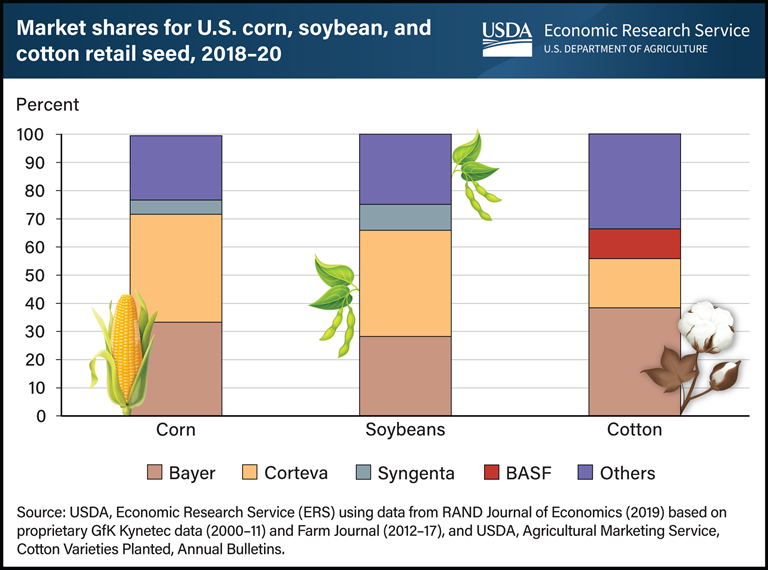|
News Bits
This year's U.S. corn and soybean harvests are nearly a quarter complete. That followed a generally good week for weather for harvest activity, with possible delays later this week from an expected cooler, wetter weather pattern in parts of the Midwest and Plains.
The USDA says 23% of U.S. corn is harvested as of Sunday and 82% of the crop is mature, both ahead of average, with 53% in good to excellent condition, unchanged on the week.
23% of U.S. soybeans are harvested, with 86% of the crop dropping leaves, faster than their respective typical paces, while 52% rated good to excellent, 2% higher.
40% of winter wheat has been planted, compared to the five-year average of 43%, and 15% has emerged, compared to 16% on average.
18% of cotton is harvested and 75% of bolls have opening, ahead of usual, with 30% of the crop in good to excellent shape, steady with a week ago.
75% of rice is harvested, compared to 69% normally in early October.
96% of sorghum is coloring, 70% is mature, and 35% is harvested, all faster than average, with 41% of the crop called good to excellent, down 2%.
35% of U.S. pastures and rangelands are reported as good to excellent, a week-to-week decline of 1%.
The USDA's weekly crop progress and condition numbers run through November.
Feed & Grain Times reports:
In a groundbreaking achievement, scientists, led by University of Nebraska-Lincoln researcher James Schnable, have successfully mapped the complete genome of corn. This milestone development promises to revolutionize the future of agriculture, offering invaluable insights into crop health, resilience, and productivity.
Published recently in the prestigious journal Nature Genetics, the study titled "A Complete Telomere-to-Telomere Assembly of the Maize Genome" represents a significant leap forward in the field of genetics, coming on the heels of the human genome's complete mapping just a year ago.
The corn genome, due to its sheer size and complexity, has long posed a formidable challenge for scientists seeking to decode its genetic makeup. Over the years, technology has made strides in this area, with the first draft of the corn genome emerging in 2009. However, numerous gaps remained, comprising over 100,000 unresolved genetic sequences.
James Schnable, the Charles O. Gardner Professor of Agronomy, explained, "Our team drew on the latest technology, plus the particular expertise of the individual team members, and that finally made possible the mapping of the complete corn genome."
A significant aspect of this achievement was the resolution of complex genetic regions containing nearly identical paralogs - genes that are so similar they were previously indistinguishable. Corn's genetic repetition presents an extraordinary challenge, with vast stretches of genetic material intermingled, making it difficult to pinpoint individual gene functions.
To read the entire report click here.
Data from the U.S. Bureau of Labor Statistics' Quarterly Census of Employment and Wages (QCEW) show wage and salaried employment in agriculture stabilized in the 2000s and has been on a gradual upward trend since 2010. U.S. agriculture employment rose from 1.11 million jobs in 2012 to 1.18 million jobs in 2022, a gain of 6 percent.
Employment growth was fastest in crop support services (27,500 jobs added, a 12-percent increase) and the livestock sector (31,400 jobs added, a 10-percent increase). Crop support services firms provide specialized services to farmers, including labor contracting and custom harvesting. By comparison, employment of direct hires in the crop sector, which has the largest number of hired farm workers, grew 1 percent.
Data from QCEW are based on unemployment insurance records, not on surveys of farms or households. As a result, they do not cover smaller farm employers in States that exempt such employers from participation in the unemployment insurance system. However, survey data sources such as the U.S. Department of Commerce, Census Bureau's American Community Survey and Current Population Survey also show rising farm employment since the turn of the 21st century.
|
 USDA RELEASES CHART SHOWING MARKET SHARES OF SEED COMPANIES
USDA RELEASES CHART SHOWING MARKET SHARES OF SEED COMPANIES USDA RELEASES CHART SHOWING MARKET SHARES OF SEED COMPANIES
USDA RELEASES CHART SHOWING MARKET SHARES OF SEED COMPANIES